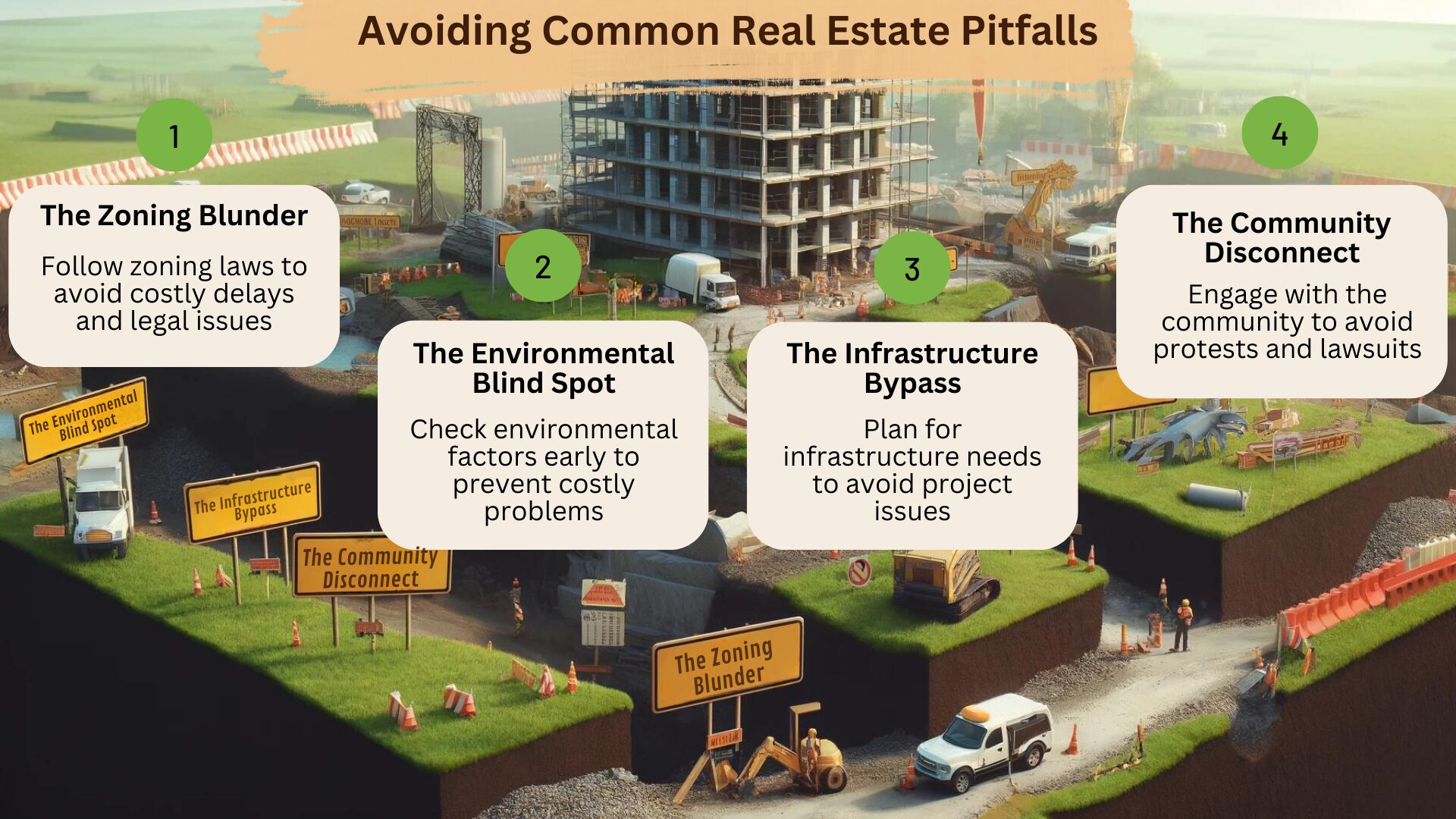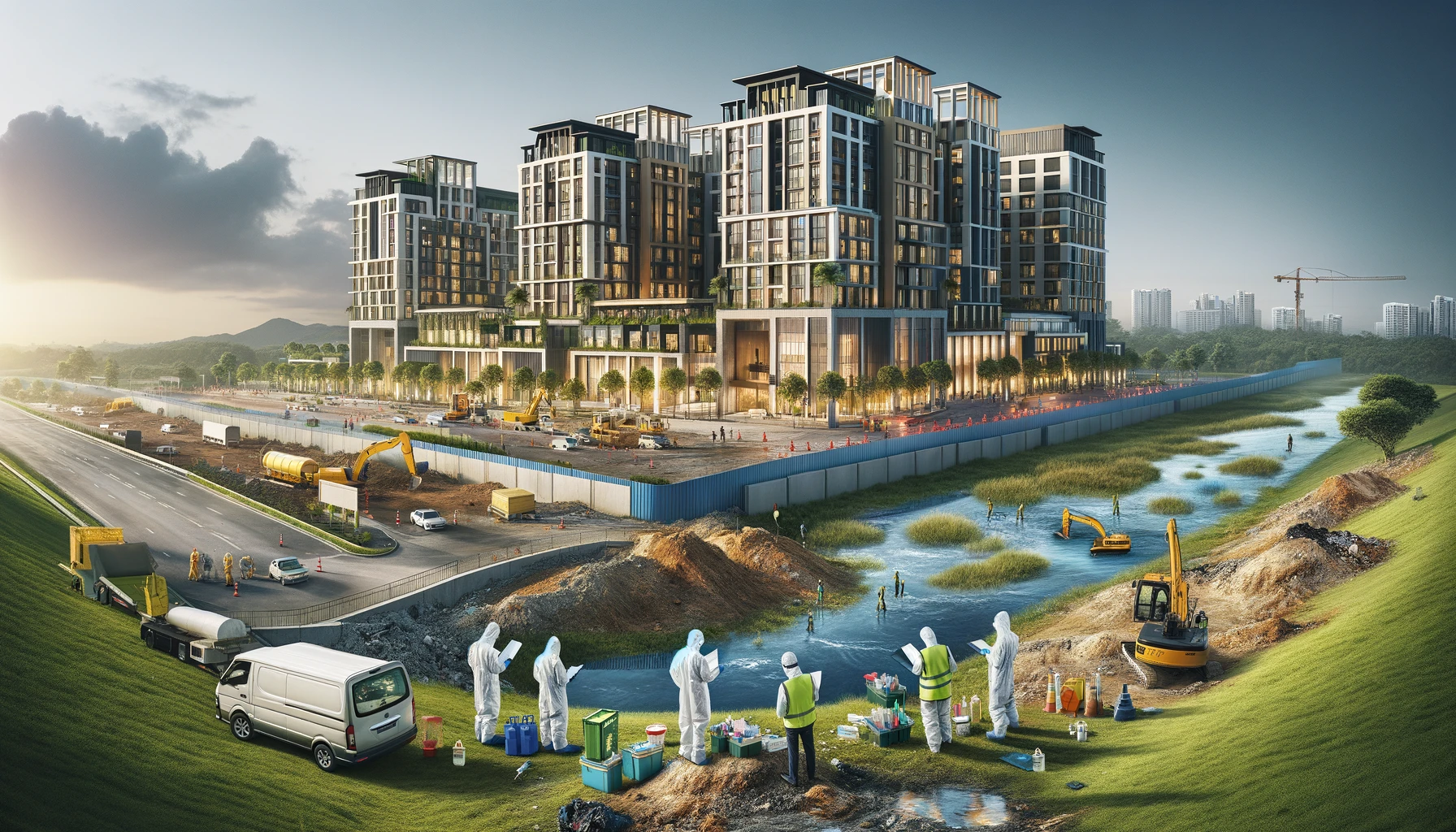Alright, listen up folks. We’re about to get real honest about the world of land development. I’ve been in this game for some time, and believe me, it’s one wild ride. The potential rewards are massive, but the risks? They can bury you six feet under if you’re not careful.
I’m not here to sugarcoat anything or spin some fantasy tale about getting stinking rich overnight. Land development is a high-stakes game where the stakes are sky-high. If you want a seat at the table, you better know the rules inside and out.
Today, we’re diving deep into four common pitfalls that have taken down even the most seasoned developers. Ignore them at your own peril, my friends.

1. The Zoning Blunder
Ah zoning regulations, the constant thorn in every developer’s side. These little rulebooks dictate exactly what you can and can’t build in an area. And let me tell you, they aren’t just polite suggestions you can brush aside whenever convenient.
I can’t count how many times I’ve watched guys get so obsessed with their grand vision that they completely disregard zoning laws. “Those rules were made to be broken,” they think. “I’m a maverick, baby! Watch me build whatever I want!”
Well, allow me to burst that delusional bubble right now. Zoning regs are the law, plain and simple. Try to skirt around them, and you’re playing a dangerous game of Russian roulette. You might get lucky for a while, but eventually that barrel’s going to go off. When it does, you’re staring down costly delays, endless revisions, and potentially even legal battles that’ll drain you dry.
I’ve lived it, seen it with my own eyes – developers losing their shirts because they couldn’t follow a few simple rules. But here’s the kicker – it’s all avoidable if you take the time upfront to understand the zoning regulations. Is it inconvenient? Sure. But a hell of a lot easier than dealing with the nuclear fallout of ignoring them.
Click here to learn more and subscribe to the newsletter
2. The Environmental Blind Spot
Next up, the elephant in the room that nobody wants to address – environmental considerations. I know, I know, just the mere mention of being eco-friendly makes some of you want to roll your eyes into the back of your head.
But hear me out for a second. This isn’t about being a tree-hugging hippie or whatever stereotypes you’ve got loaded in that brain of yours. This is cold, hard reality. Ignore environmental factors, and it could be a death sentence for your entire project.
Look, I get it. Dealing with environmental assessments, flood plains, soil contamination – it’s a massive headache. It costs time, it costs money, and sometimes it feels like an endless marathon of hoop-jumping for no good reason.
But let me paint you a picture. Imagine pouring millions into developing those luxury condos or swanky shopping plazas, only to find out halfway through that you’re building on a flood plain. Or that the soil is swimming in toxic waste. Not only does that add millions in unforeseen costs, but it could make your entire vision unfeasible.
Then there’s the PR nightmare of being branded an eco-terrorist. In today’s climate (pun very much intended), people are hyper-aware of sustainability and environmental impact. If the public sees you as a corporate bully demolishing nature, good luck selling those posh homes and commercial spaces.
The smart move? Get ahead of it from day one. Hire the experts, do the assessments, make sure you’re following every last environmental regulation to a T. It’s an upfront investment, sure, but one that’ll pay dividends compared to picking up the pieces of a botched eco-disaster down the road.

3. The Infrastructure Bypass
Alright, let’s say you managed to jump through the zoning and environmental hoops like a pro. If you think you’re in the clear, think again my friend. Because there’s another pitfall that’ll open up and swallow you whole – overlooking infrastructure.
When I say infrastructure, I’m talking roads, utilities, public services – the whole damn backbone that keeps a community running smoothly. And let me tell you, this aspect gets massively overlooked by overeager developers all the damn time.
The sad truth is, developers are often in a dead sprint race against urban growth. Cities simply can’t keep pace with the onslaught of new development, and that’s when issues start cropping up left and right.
Picture this nightmare scenario: You’ve built your dream oasis with all the bells and whistles – luxury condos, resort-style amenities, the whole nine yards. But whoops, you conveniently forgot to account for silly little things like reliable power, efficient transportation, adequate emergency services.
Now your five-star paradise is being plagued by rolling blackouts, traffic jams from hell, and overwhelmed police and fire departments. Not exactly the utopian society you were selling, is it?
That’s why infrastructure planning needs to be priority one from the very start. Work hand-in-hand with the city from the jump, aligning your plans with their big-picture roadmap for upgrading and expanding municipal services. It’s a bit more effort upfront, but trustme, it’s a drop in the bucket compared to the PR shitshow of a poorly-planned community.
Get your free “2024 Real Estate Market Outlook” now!
4. The Community Disconnect
Alright, you’ve jumped through every hoop – zoning, environmental, infrastructure, you’ve checked every last box. If you’re celebrating and cracking open the champagne, not so fast, playboy. Because there’s one more colossal pitfall that can sink even the most airtight development plan: underestimating the local community.
I get it, having to deal with the vox populi is a massive headache. These are the folks who’ve lived in the area for decades, maybe generations. They’re ferociously protective of their turf, and they won’t hesitate to voice objections early and often. Loudly.
But here’s the reality – ignoring that community input is essentially signing your own death warrant. I’ve seen too many overly-confident developers try to steamroll their way through, treating locals like stupid peasants who don’t know what’s good for them.
You know how that story ends? Protests. Lawsuits. Terrible press that’ll make you want to move to Siberia and open a yak milk farm. It’s a disaster scenario that plays out again and again.
Successful development isn’t just about erecting buildings and making bank. It’s about fostering relationships and building trust with the people who’ll actually be living in or around your project. That takes time, patience, and a willingness to truly listen.
So get out there from day one and make community engagement job number one. Host town halls, set up advisory boards, go door-to-door if you have to. And when you get that feedback, don’t just pay lip service – incorporate that local knowledge and insight into your plans. It’ll save you countless headaches down the road and lead to a better final product.
I’ve been on both sides, watching developers crash and burn because of their arrogance, and others succeed thanks to authentic community collaboration. Don’t become a cautionary tale.

Why Land Development Is Still A Smart Investment
Now, after laying out all those potential pitfalls, you might be thinking – jeez, is this whole land development game even worth it? Why would anyone want to put themselves through all that?
Well, allow me to illuminate the advantages that make land development such an attractive investment, despite the risks:
It’s a tangible asset. Unlike stocks, cryptocurrencies or other nebulous investments, land is a real, physical thing you can reach out and touch. It’s not going anywhere. That inherent stability makes it a relatively safe place to park your money, especially in a booming market like we have today.
The appreciation potential is massive. As cities continue their relentless expansion and the demand for housing/commercial space keeps climbing, land values consistently rise over time. Smart investors can get in on the ground floor in emerging areas, then benefit hugely as that area develops and prices skyrocket.
It’s an ultra-versatile investment. Land can be developed for virtually any residential, commercial, or industrial purpose you can dream up. That versatility allows you to adapt to changing markets and emerging trends. And with smart planning, land can be developed in phases for a steady stream of income.
You’re creating something tangible that lasts. For many developers, these projects go beyond just making money – it’s about crafting a real, lasting legacy that provides value to communities for generations. Done right, land development can create jobs, vital infrastructure, amenities, and catalyze an area’s growth.
So while the pitfalls are very real, if you can successfully navigate them, the rewards of land investment are hard to beat. Steady returns, incredible versatility, and the chance to truly leave your mark on the world.
Conclusion
Let’s do a final recap of the four massive pitfalls that can bury any land developer:
1) Ignoring zoning regulations
2) Neglecting environmental considerations
3) Overlooking infrastructure planning
4) Underestimating the community
Avoid those landmines, and the road to a lucrative, legacy-defining land development career is wide open.
This isn’t just bureaucratic checkbox stuff – zoning, environmental rules, infrastructure, community engagement – that’s the very foundation for success that benefits everyone involved.
So get it right from day one. Follow regulations to the letter, dot every i, cross every t. But most importantly, work hand-in-hand with the community all along the way. It’s more effort upfront for sure, but that investment pays massive dividends when you’re cutting the ribbon on your proudest achievement.
Because if you don’t? You’re staring down an ugly, costly mess that’ll make you question your entire life’s decisions. The choice is yours – walk the righteous path, or stumble into one of those man-made pitfalls. For your sake and your bank account’s sake, I implore you – choose wisely.
Interested in multifamily real estate investing? Our experienced team is here to help. From market research to identifying the best opportunities, we guide you through the process. Subscribe to our YouTube channel for informative videos and expert discussions, and follow us on Instagram for exclusive content. Explore our comprehensive Udemy course for detailed insights and strategies. Ready to elevate your investment journey? Contact us now to schedule a consultation and achieve your financial goals in real estate.
*This content is for informational purposes only and is not intended as financial or legal advice. Please consult with a professional advisor before making any investment decisions.




























